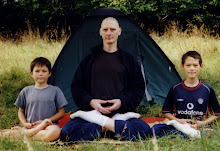Antagonistic Action (3): Ears vs Shoulders; Nose vs Navel
MIMI TO KATA TO TAI SHI, HANA TO HESO TO TAI SESHIMEN KOTO O YOSU.
MIMI means ears.
...TO ...TO are particles meaning both... and....
KATA means shoulders.
TAI SHI is an inflected form of TAI SURU, which means to oppose.
HANA means nose.
...TO ...TO is as above.
HESO means navel
TAI SESHIMEN is the causitive of TAI SURU: to cause to oppose
KOTO makes the preceding into the object clause
O is the object particle
YOSU means is vital.
Literally: “It is vital to cause the ears and shoulders, the nose and the navel, to oppose each other.”
English translations of Fukan-zazen-gi are prone to veer away from the literal translation, reflecting the translator’s endeavor to make sense of what he doesn’t necessarily understand.
The original rendering into English of Fukan-zazen-gi in the first edition of To Meet the Real Dragon (1984), by Gudo Nishijima with Jeffrey Bailey, has:
“Hold your head straight so that your ears are equidistant from your shoulders and your nose is in line with your naval.”
For the second edition of To Meet the Read Dragon (1992), I revised it as follows, in line with my intention to go for the translation that mirrored the original as closely as possible:
“The ears must be aligned with the shoulders, and the nose aligned with the navel.”
This is closer, but I think it still misses the target. The primary meaning of TAI SURU, if you look it up in the dictionary, is not to do with alignment; it is to do with opposition, antagonistic opposition. But in 1992, before I stumbled on Alexander’s teaching, I was more interested in alignment than in opposition, and so my translation reflected my own bias.
For TAISURU, the Kenkyusha dictionary gives: face, confront, be opposite to... oppose.
For the original Chinese character that Master Dogen used, TAI, the Nelson character dictionary gives: the opposite; antonym; even, equal; versus; counter-, anti-, versus.
Thus, a case can be made that Master Dogen used the character TAI to express equality, equidistance, symmetry, alignment.
But that argument, even if it comes from my own Buddhist teacher, doesn’t convince me.
The interpretation of TAI that hits the target, I think, is that TAI expresses the principle of allowing muscular release. In other words, TAI expresses the principle that when a bunch of muscle releases, the two things at either end of the bunch of muscle are released in opposite directions from each other -- irrespective of so-called good alignment, true symmetry, good or bad posture, et cetera.
This week I led a one-day workshop for Alexander teachers. The title was “immature primitive reflexes and faulty sensory appreciation.” In outlining how the reflexes develop, I highlighted the theme of antagonistic action -- how, for example, the Moro reflex opposes the fear paralysis response, how the two parts of the Moro reflex oppose each other, how the asymmetrical tonic neck reflex opposes the symmetrical pattern of the Moro reflex; how the strong tendency which the asymmetrical tonic neck reflex has to divide the baby into two sides, left and right, is opposed by postural reflexes such as the amphibian reflex and segmental rolling reflexes, and then by cross-pattern movements such as crawling on the belly and crawling hands on knees.
During the workshop I quoted to the other Alexander teachers Master Dogen’s instruction for the ears and shoulders, and nose and navel in Zazen. I just quoted it literally: “It is vital to cause the ears vis-a-vis the shoulders, and the nose vis-a-vis the navel, to oppose each other.”
The reaction I got was not: “That sounds strange” or “That sounds like Japanese English” or “What the hell is that supposed to mean?”
No, the reaction I got was simply: “What wonderful directions!”
The Alexander teachers present understood the literal translation of Master Dogen’s words, because “ears being allowed to oppose the shoulders” is just another way of saying the Alexander direction “neck being allowed to release” and “nose being allowed to oppose the navel” is just another way of saying the Alexander direction “allowing oneself to lengthen in stature.”


0 Comments:
Post a Comment
<< Home